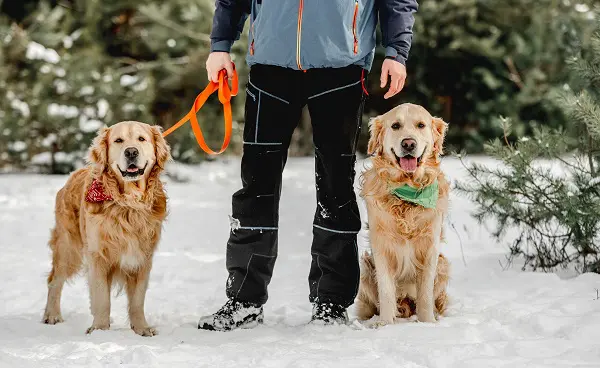We all know that dogs have fur to keep them warm during winter. But, if you live in a place where winter means snow, mild temperature, rain, and wind chills, you must have this question in your mind. Will fur coats only keep your dog warm and healthy?
Some breeds, like Siberian Huskies and Alaskan Malamutes, can withstand harsh winter and easily spend time outside. But, varieties like Chihuahuas, Grey Hounds, young dogs, or aged dogs face problems tolerating the cold weather, especially when taken outside in the winter.
Whatever the variety, it is a common belief that dogs have fur to keep them warm during winter. But the truth is that dogs are also susceptible to frostbite and hypothermia, just like human beings.
Dog owners often have a question:
- Is my dog feeling cold?
- How to keep dogs warm in winter?
- Dress for the winter months
- Keep your dog inside the house
- Keep their paws clean
- Avoid taking long walks
- Put them on a leash
- Keep dogs well-fed and hydrated
- What the pet-parents should be careful about in winter?
- When do you need to call the vet?
- Conclusion
- Subscribe to Our Newsletter
Is my dog feeling cold?
Though your dog is covered with majestic fur, it still feels cold during peak winter months. The easiest way to understand if you are feeling too cold, your dog is also feeling the same. Usually, dogs feel uncomfortable if the temperature drops below 32⁰F. But it depends upon the dog breed.
Some of the dogs may feel cold if the temperature goes below 45⁰F. It is significant to understand your dog’s capacity to tolerate cold. Whatever level of tolerance it may have, you should be prepared to keep your dog comfortable and warm when the winter season is around the corner.
How to keep dogs warm in winter?
Here are a few ways that you can practice during the winter months to keep your pet warm, comfortable, and safe.
Dress for the winter months
Clothes like dog jackets, coats, and sweaters can keep your pet warm through winter. Smaller dogs, old dogs, or dogs with less fur may need maximum help at this time of the year.
Before using the clothes, make sure they are dry. Unless the temperature within your house is too low, it is better to use clothes outside only. Otherwise, the dog will not be able to feel its benefits.
Keep your dog inside the house
If you keep your dog in a kennel on the back patio or in the garden, it is better to make a spot for them inside the house. The spot should be away from the doors and windows also. Just like you, the cold air is not good for dogs.
Spread some fluffy blankets underneath their beds for extra coziness and warmth. If you are using heaters, beware of the space. If your dog’s mat is too close to the heater and it becomes too warm, its skin can get burnt.
If you have no other choice due to space constraints or any other reason but to keep the dog in the kennel, insulate the house. The floor of the kennel should be at least 4 inches above the ground. Using straw on the kennel floor and some warm bedding on top of it can even help prevent the cold from radiating from the ground.
There are dog boardings and daycares as well that can provide a safe and warm environment for your pet. If you are going out, it is better to keep them in such places, especially in winter.
Keep their paws clean
During the walks in winter months, ice, salt, and de-icer can accumulate in dogs’ paws when they go outside for walks. Therefore, there can be something toxic and dangerous that can be mixed with these elements as well. If dogs lick their paws at that time, they are ingesting all those harmful elements. So, every time you come home from outside, make sure to clean your paws thoroughly.
Trim the nails of your dog. If it has long hair, make sure to trim the hair between the toes. Another way to protect your dog’s paws is to use booties. Booties will help keep the dog’s paws warm and protect them from build-up. Dogs usually do not like to wear booties. But, with practice, you can make them put those booties on.
Avoid taking long walks
When it is cold, the dogs should not stay outside for long. It is not safe for even the pretty tolerant dog varieties to stay outside in frigid weather, especially in the morning and late at night when the temperature remains extremely low.
You should avoid taking your pet outside during that time. Dogs, especially the smaller breeds, lose body heat very quickly. So, taking short walks for bathroom breaks can allow your pup to stay safe. Encourage your dog to play indoor games instead of going for outside exercises.
Put them on a leash
When you are taking your dog outside for a walk-in winter, always put them on a leash. It will prevent them from running too far and getting lost in a snowstorm. The ice can make the roads slippery, and if your dog goes unattended, an accident can happen. Therefore, it is significant to use a dog leash.
Keep dogs well-fed and hydrated
Steel bowls tend to be cold very soon. You can use a heated bowl designed, especially for dogs to help prevent them from having cold water or food. Often it is said that dogs should eat more during the winter to keep their metabolism up. But before changing your dog’s diet consult with the vet.
What the pet-parents should be careful about in winter?
Your pet’s tolerance to cold weather and adjustment capacity depends on its type. The thick-coated and long-haired dogs tend to be tolerant of the cold much more than the short-haired and short-legged pets. Dogs with heart disease, kidney problems, or hormonal imbalances may find it difficult to regulate their body temperature.
Too young and aged pets will also face a similar problem. If your dog has arthritis, cold weather may worsen it. You need to understand your pets’ requirements before preparing for the winter months.
When do you need to call the vet?
You should schedule a veterinary exam before the arrival of the season. It will be a good time to discuss your pet’s diet, nutritional supplements, vaccination, or other requirements that you may need for the winter.
Conclusion
During the cold season, you must keep a close eye on their behavior. If your dog is shivering, whining, sluggish, or searching for a warm place quickly take it to a warm place. If you notice any signs of frostbite or hypothermia, do not waste to call the vet. The common symptoms include severe shivering, confusion, parts of the body turning pale, and the body being cool to the touch.
These tips can help to keep your pup safe during the winter and let them enjoy the holiday season to the fullest.
 Dog Street – Best Dogs Website In India | All Dog Latest News Portal
Dog Street – Best Dogs Website In India | All Dog Latest News Portal



